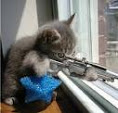 At the close of the 19th century, the Royal Navy unveiled a very fast boat named the Turbinia at the Fleet Review which was put on for Queen Victoria's diamond jubilee. Turbinia was the first successful craft driven by a steam turbine. Turbinia could reach nearly 35 knots, making her almost twice as fast as any other craft afloat.
At the close of the 19th century, the Royal Navy unveiled a very fast boat named the Turbinia at the Fleet Review which was put on for Queen Victoria's diamond jubilee. Turbinia was the first successful craft driven by a steam turbine. Turbinia could reach nearly 35 knots, making her almost twice as fast as any other craft afloat.During the era when the steam turbine was being developed, torpedoes were being developed. The first craft to carry torpedoes were light, fast boats. Somewhat larger ships, almost as fast, but more heavily armed, were developed to protect large capital ships from the threat of the torpedo boats; these ships were known as "torpedo boat destroyers." Torpedo boats would be used in wars through the Second World War. Torpedoes were also launched from larger surface ships, the Japanese "Long Lance" was the best in the world and was an extremely effective weapon. Torpedoes came into their most renown use as an antiship weapon launched from submarines, for they could be fired from periscope depth, giving the submarine the greatest possible concealment.
However, there was, at first no weapon specifically designed to fight a submarine. Gunfire was ineffective against a submerged submarine; shooting at the periscope was akin to trying to hit a broomstick at 500 yards with a rifle. And so, the first practical ASW weapon was developed: The depth charge.
The first depth charges were little more than cans filled with explosives. In a day when most buildings were heated with coal-fired furnaces, the furnaces had to be routinely cleaned of its ashes, which were put into large steel cans, or "ash cans." The depth charges were about the same size; they became known as "ash cans."
 The early depth charges ones had 50lbs of explosive; by the end of World War I, they had up to 600lbs. The technique was simple: Go to where the submarine was and roll the charges off the stern of the ship. The depth charges had a delay timer, often set by depth, to prevent blowing the stern out of the water. If the skipper had an idea which way the submarine was heading, he could try to "lead" the submarine.
The early depth charges ones had 50lbs of explosive; by the end of World War I, they had up to 600lbs. The technique was simple: Go to where the submarine was and roll the charges off the stern of the ship. The depth charges had a delay timer, often set by depth, to prevent blowing the stern out of the water. If the skipper had an idea which way the submarine was heading, he could try to "lead" the submarine.In order to get a wider pattern, the Y gun was developed. The Y gun threw two depth charges, one to either side of the ship.
 The K gun threw one depth charge:
The K gun threw one depth charge:
In the event that a submarine attacked the escort, the drill was to charge directly at the submarine at high speed (steam turbines, remember), which presented a narrow target for the sub to shoot at. If the sub was on the surface or had its periscope up, the bow guns of the destroyer would shoot at it to force the submarine below the surface. The subs of the day ran on diesels while on the surface and on batteries when submerged. The subs had to run slowly on batteries in order to conserve power, so if the destroyer could get to where the submarine was last seen (the "datum") very quickly, the destroyer would lay down a pattern of depth charges. If the submarine submerged too slowly the destroyer would ram it.
Depth charges killed in two ways. One was by concussion, which you have no doubt seen in any number of old war movies. But if the depth charge was close enough, the sub would be shattered. When an underwater charge detonates, it blows a circular bubble in the water as wide as water pressure will allow. The bubble then collapses to its center and bounces back out; this cycle repeats until it runs out of energy. But if as the bubble expands it touches a solid object, like a submarine, the bubble will collapse onto that object and blow the living shit out of it.
But there were serious drawbacks to the use of depth charges.
(To be continued)

3 comments:
Like Spring Bearings? Or are you referring to a DD not quite getting there fast enough and needing to shoot a pattern infront of the ship? I can't wait for your next post! I love hedgehogs! You ROCK EBM!
....i get it....you're a thespian.
Weapon Alpha!
Post a Comment